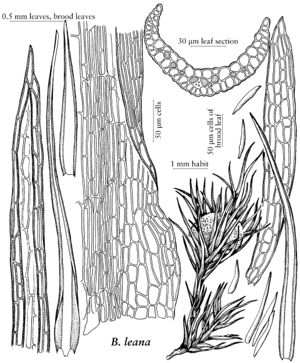Difference between revisions of "Brothera leana"
Gen. Musc. Frond., 258. 1901,.
FNA>Volume Importer |
imported>Volume Importer |
||
| (One intermediate revision by the same user not shown) | |||
| Line 61: | Line 61: | ||
|publication year= | |publication year= | ||
|special status= | |special status= | ||
| − | |source xml=https:// | + | |source xml=https://bitbucket.org/aafc-mbb/fna-data-curation/src/2e0870ddd59836b60bcf96646a41e87ea5a5943a/coarse_grained_fna_xml/V27/V27_513.xml |
|genus=Brothera | |genus=Brothera | ||
|species=Brothera leana | |species=Brothera leana | ||
Latest revision as of 21:26, 5 November 2020
Leaves 2–3 mm; margins entire; costa 155–180 µm wide; basal laminal cells 19–55 × 4–19 µm, narrower at margins; distal laminal cells 24–55 × 3–7 µm. Specialized asexual reproduction by clusters of spindle-shaped brood leaves in the comal tufts. Sporophytes not found in North America.
Habitat: Humic or peaty soil, rocks, especially sandstone bluffs, rotten wood, rarely bark of trees
Elevation: 0-2000 m
Distribution
Ark., Ill., Iowa, Ky., Md., Minn., Miss., Mo., N.C., Ohio, Pa., S.C., Tenn., Va., W.Va., Wis., Mexico, Central America (Guatemala), Asia, Africa (Malawi).
Discussion
Brothera leana is easily identified by clusters of brood leaves always present in the comal tufts. Campylopus fragilis has a similar appearance, but it has a different transverse section of the costa, with dorsal instead of median stereids. Furthermore, the ranges of the two species in North America do not overlap.
Selected References
None.
